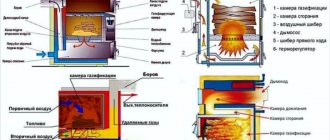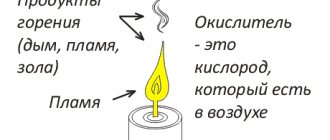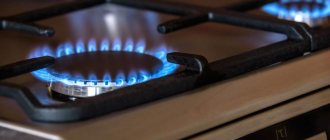What is Gcal?
A calorie is a certain amount of energy that is required to heat 1 gram of water to 1 degree.
This condition is met under atmospheric pressure conditions. For thermal energy calculations, a larger value is used - Gcal. A gigacalorie corresponds to 1 billion calories. This value began to be used in 1995 in accordance with the document of the Ministry of Fuel and Energy. In Russia, the average consumption per 1 sq.m. is 0.9342 Gcal per month. In each region, this value may change up or down depending on weather conditions.
What is a gigacalorie if it is converted into ordinary values?
- 1 Gigacalorie equals 1162.2 kilowatt-hours.
- In order to heat 1 thousand tons of water to a temperature of +1 degree, 1 gigacalorie will be required.
Calculation according to the old rules
Calculation according to the old rules (option 3) involves charging for heating in all months of the year (subparagraph “b”, paragraph 1 of the Decree of the Government of the Russian Federation of August 27, 2012 No. 857). It can be applied if there is a decision of regional authorities on this (see, for example, order of the Ministry of Housing and Communal Services of the Moscow Region dated September 13, 2012 No. 33).
This calculation option can only be used until it is canceled by the regional authorities, but it definitely loses force on July 1, 2021 (clause 6 of the Decree of the Government of the Russian Federation of May 6, 2011 No. 354, subparagraph “b” of clause 2 of the Decree of the Government of the Russian Federation dated December 17, 2014 No. 1380).
For more information on calculating the volume of transferred thermal energy according to the old rules, see the table.
Gcal in apartment buildings
In apartment buildings, gigacalories are used in thermal calculations. If you know the exact amount of heat energy that remains in the house, you can calculate the bill for heating. For example, if a house does not have a communal or individual heating device installed, then you will have to pay for centralized heating based on the area of the heated room. If a heat meter is installed, then the wiring is horizontal, or serial, or collector. In this option, two risers are made in the apartment for the supply and return pipes, and the system inside the apartment is determined by the residents. Such schemes are used in new houses. That is why residents can independently regulate the consumption of thermal energy, making a choice between comfort and savings.
The adjustment is made as follows:
- Due to the throttling of heating batteries, the passage of the heating device is limited, therefore, the temperature in it decreases and the consumption of thermal energy decreases.
- Installation of a general thermostat on the return pipe. In this option, the flow rate of the working fluid is determined by the temperature in the apartment, and if it increases, then the flow rate decreases, and if it decreases, then the flow rate increases.
Legislative regulation of payments
Currently, four Government Resolutions are considered to be the valid documents regulating the rules for calculating payments for utility services to residents of apartment buildings:
- N306 of May 23, 2006 (the procedure for establishing service consumption standards for apartment buildings was considered);
- N354 of May 6, 2011 (the procedure for providing services to residents is determined);
- N258 dated March 28, 2012 and N344 dated April 16, 2013 on amendments to the previous document (in PP N306);
- N1708 of December 28, 2021 (changes in PP N354).
The first and second documents are systematically undergoing changes, the last of which took place on April 4, 2021.
Based on these documents, each individual region of the country independently makes a decision on the choice of payment form:
- option 1 – the fee is calculated only for the heating season (usually October-May);
- option 2 – the fee is spread evenly throughout the year.
This form affects those who do not have heating meters installed to a greater extent.
And consumers with installed meters are affected by one of the main changes in the Resolution - the adjustment of calculation formulas, which now begin to take into account meter readings without taking into account installed appliances in the house.
The installation of a common building heating meter is carried out based on the decision of the residents of the apartment building. Meter verification and necessary routine maintenance are also organized by the residents of the house
However, in apartment buildings with meters, the difference in readings between the general and apartment meters is recalculated and added evenly to the payment of each consumer.
Thus, payment for heating consists of the following components: heating in the apartment + heating in the entrance .
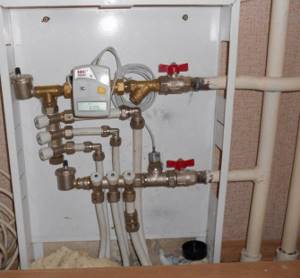
Installing individual heating meters in an apartment is currently not mandatory. However, taking into account the experience of a number of users, it can be argued that payment for thermal energy consumption by meter is lower than payment according to the established standard and tariff
In general, there are several formulas for calculating heating for each of the possible options:
- if there is a communal metering device;
- there are or are no individual appliances in the apartment/non-residential premises;
- when using heating equipment, if this equipment is considered part of the common property of the house.
Each specific case will be discussed more clearly in the following parts of the article.
Gcal in private homes
If we talk about Gcal in a private house, then residents are primarily interested in the cost of heat energy for each type of fuel. Therefore, let’s look at some prices per 1 Gcal for various types of fuel:
- Natural gas – 3300 rubles;
- Liquefied gas – 520 rubles;
- Coal – 550 rubles;
- Pellets – 1800 rubles;
- Diesel fuel – 3270 rubles;
- Electricity – 4300 rubles.
The price may vary depending on the region, and it is also worth considering that the cost of fuel increases periodically.
Example No. 1
It is necessary to determine the correct number of sections for the M140-A radiator, which will be installed in a room located on the top floor. In this case, the wall is external, there is no niche under the window sill. And the distance from it to the radiator is only 4 cm. The height of the room is 2.7 m. Qn=1410 W, and tв=18 °С. Conditions for connecting the radiator: connection to a single-pipe riser of a flow-regulated type (Dy20, KRT tap with 0.4 m inlet); The heating system is routed from the top, tg = 105°C, and the coolant flow through the riser is Gst = 300 kg/h. The temperature difference between the coolant in the supply riser and the one in question is 2°C.
We determine the average temperature in the radiator:
tav = (105 - 2) - 0.5x1410x1.06x1.02x3.6 / (4.187x300) = 100.8 °C.
Based on the data obtained, we calculate the heat flux density:
tav = 100.8 - 18 = 82.8 °C
It should be noted that there was a slight change in the level of water consumption (360 to 300 kg/h). This parameter has virtually no effect on qnp.
Qpr =650(82.8/70)1+0.3=809W/m2.
Next, we determine the level of heat transfer horizontally (1g = 0.8 m) and vertically (1v = 2.7 - 0.5 = 2.2 m) located pipes. To do this, you should use the formula Qtr = qinxlv + qrxlg.
We get:
Qtr = 93x2.2 + 115x0.8 = 296 W.
We calculate the area of the required radiator using the formula Ap = Qnp/qnp and Qпp = Qп - µ trхQtr:
Ar = (1410-0.9x296)/809 = 1.41 m2.
We calculate the required number of sections of the M140-A radiator, taking into account that the area of one section is 0.254 m2:
m2 (µ4 = 1.05, µ 3 = 0.97 + 0.06 / 1.41 = 1.01, we use the formula µ 3 = 0.97 + 0.06 / Ar and determine:
N=(1.41/0.254)x(1.05/1.01)=5.8. That is, the calculation of heat consumption for heating showed that in order to achieve the most comfortable temperature in the room, a radiator consisting of 6 sections should be installed.
This is the ratio of Kal and Gcal to each other.
1 Cal 1 hectoCal= 100 Cal 1 kiloCal (kcal)= 1000 Cal 1 megaCal (Mcal)= 1000 kcal = 1000000 Cal 1 gigaCal (Gcal)= 1000 Mcal = 1000000 kcal = 1000000000 Cal
When they say or write on receipts, Gcal - we are talking about how much heat was supplied to you or will be supplied for the entire period - this could be a day, a month, a year, a heating season, etc. When they say or write Gcal/hour, this means how much heat they will release to you and me in one hour. If the calculation is for a month, then we multiply these ill-fated Gcal by the number of hours per day (24 if there were no interruptions in heat supply) and days per month (for example, 30), but also when we actually received heat.
What is a Gigacalorie and how many calories are in it?
The concept of Gigacalories is most often found in documents in the field of thermal power engineering. This value can be found in receipts, notices, payments for heating and hot water.
It means the same thing as a calorie, but in a larger volume, as evidenced by the prefix “Giga”. Gcal determines that the original value has been multiplied by 109. In simple terms: 1 Gigacalorie contains 1 billion calories.
Like the calorie, the Gigacalorie does not belong to the metric system of physical quantities.
The table below shows an example comparison of values:
| Console | Number of calories |
| kcal (kilocalorie) | 1 000 |
| Mcal (megacalorie) | 1 000 000 |
| Gcal (gigacalorie) | 1 000 000 000 |
The need to use Gcal is due to the fact that when heating the volume of water needed for heating and household needs of the population, even 1 residential building releases a colossal amount of energy. Writing numbers denoting it in documents in calorie format is too long and inconvenient.
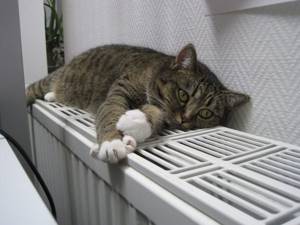
A value such as a gigacalorie can be found in payment documents for heating
You can imagine how much energy is spent during the heating season on an industrial scale: when heating 1 block, district, city, country.
Calculation using the payment frequency coefficient
Calculation using the payment frequency coefficient (option 2) can be used only if there are no communal and individual (apartment) metering devices.
Calculate the volume of transferred thermal energy according to the standards, and charge the fee monthly.
Calculate the payment frequency coefficient using the formula:
| Payment frequency factor | = | Number of months of the heating season in a year | : | 12 |
This is stated in subparagraph “a” of paragraph 1 of Decree of the Government of the Russian Federation of August 27, 2012 No. 857 and paragraphs 1 and 2 of the Rules approved by Decree of the Government of the Russian Federation of August 27, 2012 No. 857.
The number of months of the heating season per year is determined by regional regulations.
For more details on calculating the volume of transferred thermal energy using the payment frequency coefficient, see the table.
General principles for performing Gcal calculations
Calculating kW for heating involves performing special calculations, the procedure of which is regulated by special regulations. Responsibility for them lies with utility organizations that are able to help with this work and give an answer regarding how to calculate Gcal for heating and the decoding of Gcal.
Of course, such a problem will be completely eliminated if there is a hot water meter in the living room, since it is in this device that there are already pre-set readings that display the heat received. By multiplying these results by the established tariff, it is possible to obtain the final parameter of the heat consumed.
How to calculate the consumed thermal energy?
If for one reason or another there is no heat meter, then to calculate thermal energy you must use the following formula:
Let's look at what these symbols mean.
1. V denotes the amount of hot water consumed, which can be calculated either in cubic meters or in tons.
2. T1 is the temperature indicator of the hottest water (traditionally measured in the usual degrees Celsius). In this case, it is preferable to use exactly the temperature that is observed at a certain operating pressure. By the way, the indicator even has a special name - enthalpy. But if the required sensor is missing, then as a basis you can take the temperature regime that is extremely close to this enthalpy. In most cases, the average is approximately 60-65 degrees.
3. T2 in the above formula also denotes the temperature, but of cold water. Due to the fact that it is quite difficult to penetrate the main line with cold water, constant values are used as this value, which can change depending on the climatic conditions outside. So, in winter, when the heating season is in full swing, this figure is 5 degrees, and in the summer, when the heating is turned off, 15 degrees.
4. As for 1000, this is the standard coefficient used in the formula in order to obtain the result in gigacalories. It will be more accurate than if you used calories.
5. Finally, Q is the total amount of thermal energy.
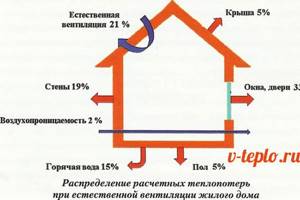
As you can see, there is nothing complicated here, so we move on. If the heating circuit is of a closed type (and this is more convenient from an operational point of view), then the calculations must be made slightly differently. The formula that should be used for a building with a closed heating system should look like this:
Now, accordingly, to the decoding.
1. V1 indicates the flow rate of the working fluid in the supply pipeline (typically, not only water, but also steam can act as a source of thermal energy).
2. V2 is the flow rate of the working fluid in the return pipeline.
3. T is an indicator of the temperature of a cold liquid.
4. T1 – water temperature in the supply pipeline.
5. T2 – temperature indicator that is observed at the outlet.
6. And finally, Q is the same amount of thermal energy.
It is also worth noting that the calculation of Gcal for heating in this case depends on several notations:
- thermal energy that entered the system (measured in calories);
- temperature indicator during the removal of working fluid through the return pipeline.
How are Gcal calculated for hot water and heating?
Heating is calculated using formulas similar to the formulas for finding the value of Gcal/h.
An approximate formula for calculating payment for warm water in residential premises:
P i gv = Vi gv * T x gv + (V v cr * Vi gv / ∑ Vi gv * T v cr)
Values used:
- P i gv – the required value;
- V i gv – volume of hot water consumption for a certain time period;
- T x gw – established tariff fee for hot water supply;
- V v gv – the volume of energy expended by the company that heats it and supplies it to residential/non-residential premises;
- ∑ V i gw – the sum of warm water consumption in all rooms of the house in which the calculation is made;
- T v gv – tariff payment for thermal energy.
This formula does not take into account the atmospheric pressure indicator, since it does not significantly affect the final desired value.
The formula is approximate and is not suitable for independent calculation without prior consultation. Before using it, you need to contact local utility services for clarification and adjustment - perhaps they use other parameters and formulas for calculation.

Calculating the size of the heating fee is very important, since often impressive amounts are not justified
The result of the calculations depends not only on the relative temperature values - it is directly influenced by the tariffs established by the government for the consumption of hot water supply and space heating.
The computational process is greatly simplified if you install a heating meter in an apartment, entrance or residential building.
It is worth considering that even the most accurate meters can allow errors in calculations. It can also be determined by the formula:
E = 100 *((V1 – V2)/(V1 + V2))
The presented formula uses the following indicators:
- E – error;
- V1 – volume of hot water supply consumed upon receipt;
- V2 – consumed hot water at the outlet;
- 100 is an auxiliary coefficient that converts the result into percentages.
In accordance with the requirements, the average error of the calculation device is about 1%, and the maximum permissible is 2%.
Calculation when the number of residents changes
If any of the permanent residents will be absent from a residential premises not equipped with meters for more than 5 full calendar days in a row during the month, calculate the volume of hot (cold) water transferred for individual needs in a special manner.
Recalculate the amount of payment for utility services in proportion to the number of days of temporary absence of the consumer. In this case, take into account the number of days of absence from the place of residence, excluding the day of departure from the place of residence and the day of arrival.
Recalculate only if there is a consumer statement about it. A person can submit an application:
- before the start of the period of temporary absence;
- within 30 days after the end of the period of temporary absence.
He must attach documents to the application confirming the fact of absence from his place of residence. These could be, for example:
- a copy of a travel certificate or a business trip certificate certified at the place of work;
- certificate of being treated in a hospital facility;
- travel tickets issued in the name of the consumer (copies thereof);
- invoices for accommodation in a hotel, hostel or other place of temporary stay or copies thereof;
- certificate of registration at the place of residence;
- a certificate from the organization providing security for the residential premises in which the consumer was temporarily absent;
- a certificate from a consular or diplomatic office confirming the citizen’s temporary stay outside Russia;
- a copy of the passport with border crossing marks;
- a certificate from a dacha, gardening, vegetable gardening partnership, confirming the period of temporary stay of a citizen at the location of the dacha, gardening, vegetable gardening partnership;
- other documents confirming the consumer’s temporary absence.
Utility payments for general house needs do not need to be recalculated.
This procedure is established in paragraphs 86–93 of the Rules, approved by Decree of the Government of the Russian Federation of May 6, 2011 No. 354.
Other ways to determine the amount of heat
Let us add that there are also other methods by which you can calculate the amount of heat that enters the heating system. In this case, the formula is not only slightly different from those given below, but also has several variations.
As for the values of the variables, they are the same as in the previous paragraph of this article. Based on all this, we can confidently conclude that it is quite possible to calculate the heat for heating on your own. However, one should not forget about consulting with specialized organizations that are responsible for providing housing with heat, since their methods and principles of calculations may differ, significantly, and the procedure may consist of a different set of measures.
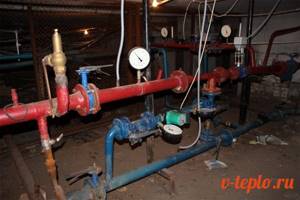
If you intend to equip a “warm floor” system, then prepare for the fact that the calculation process will be more complex, since it takes into account not only the characteristics of the heating circuit, but also the characteristics of the electrical network, which, in fact, will heat the floor. Moreover, the organizations that install this kind of equipment will also be different.
Note! People often encounter the problem of converting calories into kilowatts, which is explained by the use of a unit of measurement in many specialized manuals, which is called “C” in the international system. >
In such cases, it is necessary to remember that the coefficient due to which kilocalories will be converted into kilowatts is equal to 850. In simpler terms, one kilowatt is 850 kilocalories. This calculation option is simpler than those given above, since the value in gigacalories can be determined in a few seconds, since a Gcal, as noted earlier, is a million calories.
In order to avoid possible mistakes, we should not forget that almost all modern heat meters operate with some error, albeit within acceptable limits. This error can also be calculated by hand, for which you need to use the following formula:
Traditionally, now we find out what each of these variable values means.
1. V1 is the flow rate of the working fluid in the supply pipeline.
2. V2 – a similar indicator, but in the return pipeline.
3. 100 is the number by which the value is converted to a percentage.
4. Finally, E is the error of the accounting device.
According to operational requirements and standards, the maximum permissible error should not exceed 2 percent, although in most meters it is somewhere around 1 percent.
As a result, we note that a correctly calculated Gcal for heating can significantly save money spent on heating the room. At first glance, this procedure is quite complicated, but - and you have seen this personally - if you have good instructions, there is nothing difficult about it.
Option 3
We have one last option left, during which we will consider the situation when the house does not have a heat meter. The calculation, as in previous cases, will be carried out according to two categories (thermal energy consumption per apartment and ADN).
We will calculate the amount for heating using formulas No. 1 and No. 2 (rules on the procedure for calculating thermal energy, taking into account the readings of individual metering devices or according to established standards for residential premises in Gcal).
Calculation 1
Formula No. 1: 1.3 x 1,400 = 1,820 rubles, where:
- 1.3 Gcal – individual meter readings;
- 1,400 rub. – approved tariff.
Formula No. 2: 0.025 x 70 x 1,400 = 2,450 rubles, where:
- 0.025 Gcal – standard indicator of heat consumption per 1 m² of living space;
- 70 m² – total area of the apartment;
- 1,400 rub. – approved tariff.

As in the second option, the payment will depend on whether your home is equipped with an individual heat meter. Now it is necessary to find out the amount of heat energy that was spent on general house needs, and this must be done according to formula No. 15 (volume of services for one-room service) and No. 10 (amount for heating).
Why do housing and communal services overestimate the amount of energy spent when paying for heating?
When making your own calculations, it is worth noting that housing and communal services slightly overestimate the standards for thermal energy consumption. The idea that they are trying to earn extra money from this is wrong. After all, the cost of 1 Gcal already includes maintenance, salaries, taxes, and additional profit. This “surcharge” is due to the fact that when hot liquid is transported through a pipeline in the cold season, it tends to cool down, that is, inevitable heat loss occurs.
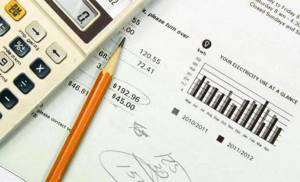
In numbers it looks like this. According to regulations, the temperature of water in heating pipes must be at least +55 °C. And if we take into account that the minimum temperature of water in power systems is +5 °C, then it must be heated by 50 degrees. It turns out that 0.05 Gcal is used for each cubic meter. However, in order to compensate for heat loss, this coefficient is inflated to 0.059 Gcal.
What to do if the accrual is incorrect?
Unfortunately, many consumers are increasingly faced with the problem of incorrect charges. An unscrupulous accountant of the management company, errors in accruals, any inattention caused by someone else - all this ultimately falls on the shoulders of the thermal energy consumer.
Before paying the received receipt, you must check all the data given in it with your calculations.
If an error is identified at this stage, there are several ways to solve the problem:
- Write a statement/complaint to the management company.
- File a complaint with the State Housing Inspectorate.
- File a complaint with Rospotrebnadzor.
- File a complaint with the prosecutor's office.
- Apply to the court.
When submitting a written application to the Management Company, you need to make sure that there has been no increase in the tariff. If the tariff remains the same, then often, after writing such a statement, the company will find an error in the charges and agree to a meeting.
Using a claim, you can determine the procedure for returning overpaid funds:
- return in money;
- recalculation against future payments.
You can file complaints with Rospotrebnadzor and the State Housing Inspectorate if the management company deliberately inflates tariffs. In this case, the application/claim is submitted in person or sent by registered mail. Based on the results of the inspection of these structures, an administrative penalty may be imposed on the Management Company.
An appeal to the prosecutor's office occurs when previous authorities do not solve the problem that has arisen. And when going to court, it is necessary to have irrefutable evidence of identified violations in the calculations.
Convert Gcal to kW/hour
Thermal energy can be measured in various units, but in official documentation from housing and communal services it is calculated in Gcal. Therefore, it is worth knowing how to convert other units to gigacalories.
The easiest way to do this is when the relationships between these quantities are known. For example, it is worth considering watts (W), in which the energy output of most boilers or heaters is measured.
Before considering the conversion to this Gcal value, it is worth remembering that, like a calorie, a watt is small. Therefore, kW (1 kilowatt equals 1000 watts) or mW (1 megawatt equals 1000,000 watts) are more often used.
In addition, it is important to remember that power is measured in W (kW, mW), but kW/h (kilowatt-hours) is used to calculate the amount of electricity consumed/produced. In this regard, it is not the conversion of gigacalories to kilowatts that is considered, but the conversion of Gcal to kWh.

How to do this? In order not to suffer with formulas, it is worth remembering the “magic” number 1163. This is exactly how many kilowatts of energy must be spent in an hour to get one gigacalorie. In practice, when converting from one unit of measurement to another, you simply need to multiply the number of Gcal by 1163.
For example, let's convert into kW/hour 0.05 Gcal required to heat one cubic meter of water by 50 °C. It turns out: 0.05 x 1163 = 58.15 kW/hour. These calculations will especially help those who are thinking about changing gas heating to more environmentally friendly and economical electric heating.
If we are talking about huge volumes, we can convert it not into kilowatts, but into megawatts. In this case, you need to multiply not by 1163, but by 1.163, since 1 mW = 1000 kW. Or simply divide the result obtained in kilowatts by a thousand.
Metering devices for houses and apartments
A special device allows you to accurately calculate tariffs for water supply, electricity, gas and heat. Users are allowed to install a heat meter to record heat energy consumption. The device measures in Gcal/h, kW/h and kJ/h. Popular today.
Vane meters
The vane meter operates effectively at temperatures below 22 degrees.
The meter has the form of a mechanism with a perpendicular axis of rotation. The model is characterized by low sensitivity, which allows you to accurately measure heat costs. The regulators are suitable for rooms with good thermal insulation and temperatures of +26 degrees. The vane device, when adjusting the temperature up to +22 degrees, counts a minimum of Gcal.
Advantages:
- inexpensive cost;
- power supply from batteries;
- ease of use;
- accuracy of measurements.
Minuses:
- risk of breakdowns due to water hammer;
- rapid wear of the mechanism;
- increased pressure in the system;
- When the impeller jams, the water flow is not allowed to pass through.
Vane-type devices are suitable for taking readings when a small volume of water is used.
Devices with jump recorders
Electronic devices are more expensive, but they count gigacalories more accurately.
The pulse device takes readings remotely from 2-16 channels, so it is suitable for a private or apartment building. Data recording and transmission is carried out on an LCD monitor, via a plug-in interface, to a laptop or computer using a network cable, or via a GSM network.
The scenario for which readings need to be measured is specified by the user. Ultrasonic devices can be connected to the water and gas supply system, are part of the ASKUE system, or can be combined with the “smart home” system.
Advantages:
- many options for public and private measurements;
- possibility of integration into several accounting systems;
- strength due to the absence of moving parts;
- beautiful appearance and compactness;
- protection from dust and moisture – the meter can be placed in the kitchen or outdoors;
- durable body;
- self-diagnosis functions for problems;
- extensive communication;
- execution with or without a removable computing unit;
- the period between inspections is 6 years, between replacements is 10 years.
Minuses:
- high price;
- communication capabilities depend on the specifics of the output;
- costs for the purchase of flow meters, pressure sensors, remote control modules for basic equipment.
For outdoor use, models with difference recorders with a moisture protection level of IP 68 are suitable.
How to calculate how many gigalories per cubic meter. meter as an example
Measures of energy and volume are different quantities. Simple calculations will help you compare them.
Example: The coolant temperature in an apartment building should be at least 55 ⁰C, the cold water temperature should be approximately 5 ⁰C.
To heat a cubic meter you will need:
(55-5)×0.001=0.05 Gcal.
Heat losses due to imperfect thermal insulation are inevitable; losses of 20% are included in the calculations. This means that actually heating will require 0.06 Gcal.
This ratio allows the heat meter to determine the consumption of heated water.
Example: in a 100-apartment residential building, the heat meter showed 150 Gcal in the summer, when only coolant for domestic needs is consumed. In 20 apartments, hot water consumption is determined by individual meters; the total consumption for these apartments was 400 m³.
The whole house consumes: 150÷0.06=2500 m³. This means that the remaining apartments account for: 2500-400 = 2100 m³. Next, 2100 m³ is divided by the actual number of residents.
This technique allows you to convert thermal energy values into volumetric coolant flow rates and vice versa.
In houses with an open heating system, the difference in water meter readings on the supply and return pipes will indicate the amount of coolant consumed for heating and, after recalculation, the heat energy consumption.
The calculations are for reference only and serve to control the consumption of heat and water supply.
Heat meters
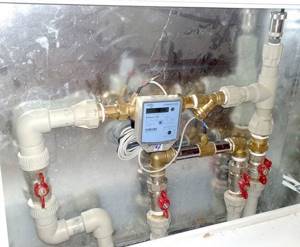
In order to calculate thermal energy you need to know the following information:
- The temperature of the liquid at the inlet and outlet of a certain section of the pipeline.
- The flow rate of liquid that moves through heating devices.
Consumption can be determined using heat meters. Heat meters can be of two types:
- Vane counters. Such devices are used to measure thermal energy, as well as hot water consumption. The difference between such meters and devices for metering cold water is the material from which the impeller is made. In such devices it is most resistant to high temperatures. The operating principle is similar for the two devices:
- The rotation of the impeller is transmitted to the metering device;
- The impeller begins to rotate due to the movement of the working fluid;
- The transfer is carried out without direct interaction, but with the help of a permanent magnet.
Such devices have a simple design, but their response threshold is low. They also have reliable protection against reading distortion. Using an antimagnetic screen, the impeller is prevented from braking by the external magnetic field.
- Devices with a difference recorder. Such meters operate according to Bernoulli's law, which states that the speed of a liquid or gas flow is inversely proportional to its static movement. If the pressure is recorded by two sensors, the flow can be easily determined in real time. The counter involves electronics in the design. Almost all models provide information on the flow and temperature of the working fluid, and also determine the consumption of thermal energy. You can configure the work manually using a PC. You can connect the device to a PC via a port.
Many residents are wondering how to calculate the amount of Gcal for heating in an open heating system in which hot water can be selected. Pressure sensors are installed on the return and supply pipes at the same time. The difference in the flow rate of the working fluid will show the amount of warm water that was spent for domestic needs.
Conversion table from Megawatt to Gigacalories per hour
MegawattGigacalories per hour
| 10 | 50 | 100 | 250 | 500 | 1 000 | 2 500 | 5 000 |
| 8.598 | 42.992 | 85.985 | 214.961 | 429.923 | 859.845 | 2 149.613 | 4 299.226 |
Sources
- https://baltgazservice.ru/stati/otoplenie/formula-rascheta-gkal-po-otopleniyu/
- https://kip-mtr.ru/gkal-chto-eto/
- https://teplo.guru/elektrichestvo/chto-takoe-gigakaloriya.html
- https://stroi-mario.ru/montazh-i-obsluzhivanie/edinica-izmereniya-tepla.html
- https://teplosten24.ru/chto-takoe-gkal-v-otoplenii.html
- https://FB.ru/article/335378/gigakaloriya—eto-chto-takoe
- https://ProUteplenie.com/otoplenie/gkal-chto-eto-kak-perevesti-gkal
- https://o-vode.net/vodosnabzhenie/gvs/gkal-v-1-m3
- https://www.calc.ru/kilovatt-v-gigakaloriy_v_chas.html
- https://www.calc.ru/gigakaloriy_v_chas-v-megavatt.html
- https://www.calc.ru/kilokaloriy_v_chas-v-kilovatt.html
- https://masterfibre03.ru/kotel/perevod-gaza-v-gkal.html
- https://www.calc.ru/megavatt-v-gigakaloriy_v_chas.html
